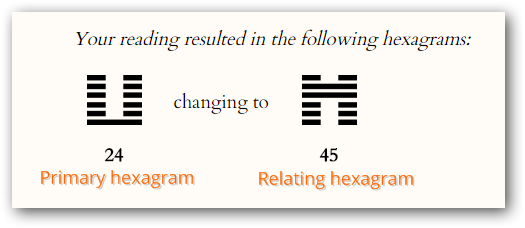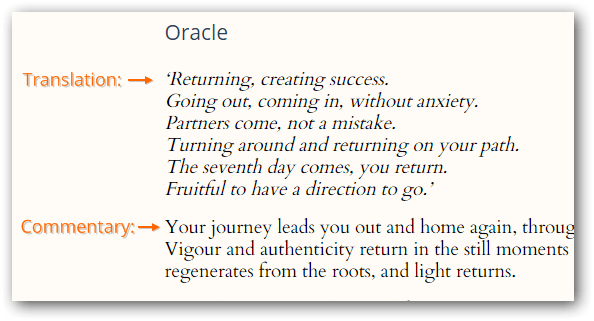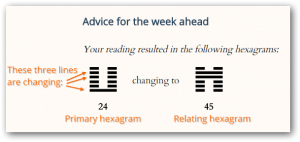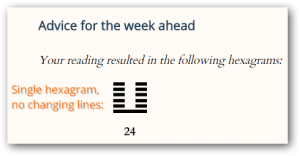So you have your reading – Yi’s answer to your question.
The first step to understanding it is to have an overview of how the different parts fit together…
Actually, wait, that’s not true. The very first step to understanding is to recognise that this normally takes time. There may be parts of your reading that just jump out and speak to you absolutely clearly – Yi can be like that, especially for newcomers – but it’s normal to need to spend some time reflecting on a reading and letting it sink in.
In other words, if you don’t understand it all at first, this does not mean anything is wrong. It means you’re at the beginning of the process of connecting to a Yijing reading, where heaven-knows-how-many millions of people have begun before you and still more will after you. All is well.
Now… the second step to understanding is to get an overview of the parts of your reading, the different roles they play, and how they fit together. This is key to getting the message of your reading as a whole – and it’s also how you avoid getting baffled by apparent ‘contradictions’ between the different parts.
If you’ve come to this page straight from Clarity’s free online I Ching reading, you’ll see something like this at the top of your ‘reading’ page:
 The Primary Hexagram
The Primary Hexagram
The primary hexagram is the hexagram you cast. This is the basis of your answer, like the setting and scenario for a film, or the subject of a lesson. (For instance – ‘What if I tried this?’ ‘Already Across: you’d be already across the river, and that means…’ Or ‘How can I reach that?’ ‘Waiting: you need to wait, and here’s how you do that…’)
Start reading here, with your primary hexagram’s name and oracle texts.
A note about translation and commentary:
Almost any Yijing book will include the translator’s commentary: their ideas about what the hexagrams and lines can mean in a reading. Of course this can be very helpful, but it is only the translator’s ideas, and they won’t always apply to your unique situation. All that really matters is what Yi says.
Make sure you can tell which words are from Yi and which are just from the translator. In Clarity’s online reading, the words of the oracle are in italics, and followed by the commentary.

(In the free online reading with my own translation, the commentary is missing from the moving lines, because my publisher would really like it if you bought the book – and come to think of it, so would I. It’s available here.)
If your primary hexagram included some changing lines…
The relating hexagram
The changing lines reveal the relating hexagram. There are many ways it can work together with the primary hexagram (see Yijing Foundations module 4, Primary and Relating Hexagram for an in-depth explanation), but the two most useful ways to think of it are as
- the backdrop to the reading, and
- what it’s about for you, or the relationship you have to the basic situation as represented in the primary hexagram.
In the relating hexagram you read the main texts about this hexagram as a whole, but none of the line texts. (Clarity’s free reading automatically displays only those texts that are part of your reading.)
The changing lines
Each line of your primary hexagram could be stable, or it could be changing into its opposite – from solid ![]() to broken
to broken ![]() , or vice versa.
, or vice versa.
If you cast your reading with coins, you noted down which lines were changing – which had a value of 6 or 9 – as you cast them. If you cast your reading online, the results page will either show you a single hexagram with no changing lines, or two hexagrams if you had a line or lines changing.



